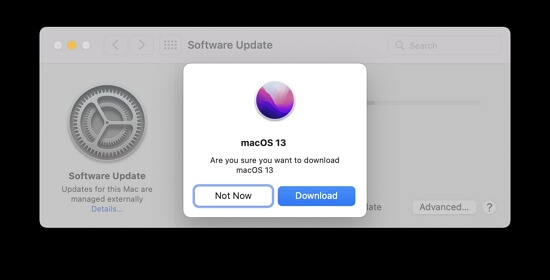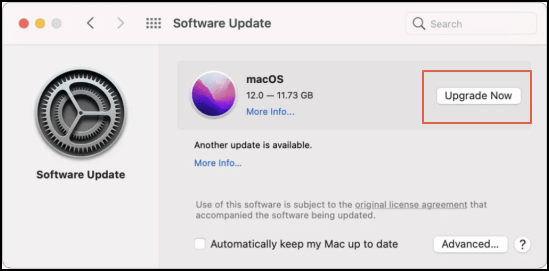How to Download and Install macOS 13 Ventura [Step by Step Navigation]
An Overview of macOS 13 Ventura
Apple published macOS 13 Ventura beta version on June 6, 2022, and this is the latest macOS version. macOS 13 Ventura is a significant update that brings us a new multitasking model and adds more features in this latest version. Let us view the main features of macOS 13 Ventura:
Main New Features of macOS 13Ventura
- Development of mail app. macOS Ventura will offer more brilliant search suggestions and corrections, and Mac users are allowed to set a scheduled email or undo the email.
- Continuity Camera. Mac users can use iPhone as the webcam for the Mac. Use a stand to put your iPhone on top of the Mac, and then your Mac and iPhone will connect automatically.
- Hand-off in FaceTime. You can transfer the calls between Mac and Apple mobile devices, and the Bluetooth headset will automatically connect to the device on which you answer the call.
- Development of Safari. It can support web page image translation and adds language support for Turkish, Thai, Vietnamese, Polish, Indonesian, and Dutch.
View the completely new features on Apple's official website.

macOS Ventura Update Requirements
Not all mac devices can update to macOS Ventura. Check the list to make sure your Mac can run macOS Ventura.
- MacBook (2017 and newer)
- MacBook Air (2018 and newer)
- MacBook Pro (2017 and newer)
- Mac mini (2018 and newer)
- Mac Studio (2022)
- iMac (2017 and newer)
- iMac Pro (2017)
- Mac Pro (2019 and newer)
macOS Ventura supports Macs with Intel's 7th generation Kaby Lake chips or newer and Apple Silicon. But there are some features that non-M1 or M2 devices will miss out on, such as using your voice to insert emojis and live captions in FaceTime.
We will teach you how to download and clean install macOS Ventura in the next part.
How to Download and Install macOS Ventura Step by Step
First, you should ensure your device can run macOS Ventura. If you are unsure, check it under the About this Mac tab. We have offered the available Mac devices before, and you can recheck the list.
Steps to Download and Install macOS Ventura
Now we can start downloading macOS 13 Ventura on your available Mac device.
Step 1. Start your App Store and type in macOS Ventura. You can get the old version in the App Store, too.
Step 2. Click "Get" to download.
Step 3. Click "Download" to confirm, then download will begin.

Step 4. When the download process is finished, the intallation will start automatically. Wait and don't close the Mac device.
How to Install macOS Ventura from USB
Some users may need to download macOS Ventura on USB flash drive and install from it on different Mac devices. Now we can teach you how to clean install macOS from USB devices. You need to prepare a USB flash drive bigger than 16 GB and format it, and remember to back up important data with Time Machine or third-party backup software. Then we will apply the 'createinstallmedia' command to create a bootable installer.
Step 1. Find the Applications/Utilities folder in the Finder, and then double-click Terminal.
Step 2. We suggest you type the following commands and paste them into Terminal. (You may require to replace MyVolume with the actual name of your USB flash drive.)
Sudo/Applications/Install/macOS/Ventura.app/Contents/Resources/createinstallmedia --volume /Volumes/MyVolume
Step 3. Press the Return to confirm the command.
Step 4. You will be asked to enter the password and confirm to erase all the data on the USB drive.
Step 5. Now you can boot your Mac from the bootable installer.
How to Upgrade to macOS 13 (Ventura)
Maybe you don't know the differences between macOS update and clean install. Compared to a clean installation, you don't have to worry about formatting the hard drive if you upgrade to macOS Ventura with the Software Update option. The new operating system will replace the old one automatically, and you can keep your files and programs.
Just follow the tutorial to upgrade to macOS 13 Ventura and ensure your Mac always connects to the internet.
Step 1. Find System Preferences from the Apple menu.

Step 2. Click "Software Update".
Step 3. Available macOS will show up, and wait until macOS Ventura appears.
Step 4. Click "Upgrade Now" to start upgrading.

Recover Lost Data When macOS 13 Ventura Installation Stuck/Failed
The installation of macOS Ventura may get stuck or fail because there is not enough space or disconnect from the internet. Then you will find you lost the necessary data because the installation is stuck. Is it possible to get back these lost files and folders? You can get them back with Mac data recovery software – Deep Data Recovery for Mac.
This reliable recovery tool can help you get back deleted files quickly. It can recover deleted files on macOS Ventura soon after the installation is stuck.
If you delete files and folders and empty the Mac Trash accidentally, Deep Data Recovery also can help you with Mac trash recovery.
If you finished downloading Deep Data Recovery for Mac, continue to read the tutorial.
How to Recover Lost Data After macOS 13 Ventura Installation Stuck with Qiling Data Recovery Tool
It only takes three steps to recover the lost data after macOS Ventura with Deep Data Recovery.
Step 1. Select file types and click "Next" to start
Launch Deep Data Recovery on your Windows computer. Select file types and click "Next" to start.

Step 2. Select the drive to be scanned
In the main Deep Data Recovery window, there will be a list of the drives connected to your PC. Select the drive you need to recover lost/deleted files from, and click the "Search for lost files" button.

Step 3. Select your lost data/files
Deep Data Recovery for Mac will immediately scan your selected disk volume and display the scanning results on the left pane. You can sort the results to find the wanted files if you are looking for certain files.

Step 4. Recover lost/deleted data
Once you have found the desired files, preview the files and then click "Recover" to begin the recovery of your deleted/lost Mac files.
Download macOS 13 Ventura FAQs
We list five additional questions and answers to help you know more about downloading and installing macOS Ventura.
Which Macs will get macOS 13?
Here is the list to help you check if your Mac can run macOS 13 or not.
- MacBook (2017 and newer)
- MacBook Air (2018 and newer)
- MacBook Pro (2017 and newer)
- Mac mini (2018 and newer)
- Mac Studio (2022)
- iMac (2017 and newer)
- iMac Pro (2017)
- Mac Pro (2019 and newer)
How do I install macOS 13 Ventura beta on Mac?
You can download macOS 13 Ventura beta from developer.apple.com. And then follow the leads:
- 1. After downloading, you can open the macOSDeveloperBetaAccessUtility.dmg file.
- 2. Double-click macOSDeveloperBetaAccessUtility.pkg to run the installer.
- 3. When the installer download progress is finished, it will open Software Update with the macOS 13 beta.
- 4. Click "Update Now" to install macOS 13Ventura beta.
Why can't I install macOS Ventura on my Mac?
Your Mac is not capable of macOS Ventura. The following Mac devices can run macOS Ventura:
- MacBook (2017 and newer)
- MacBook Air (2018 and newer)
- MacBook Pro (2017 and newer)
- Mac mini (2018 and newer)
- Mac Studio (2022)
- iMac (2017 and newer)
- iMac Pro (2017)
- Mac Pro (2019 and newer)
How do I manually download a Mac Ventura update?
You can download all the macOS versions from the Apple App Store. Type in macOS Ventura and click "Get" to download and update.
How do I set up Time Machine on my Mac?
You can choose "System Preferences" under the Apple menu, and then you will see Time Machine. You can select the name of your disk and start backing up.
Related Articles
- How to Solve Samsung Smart TV USB Not Working [Updated 2023]
- Fix Windows 10 Computer Keeps Freezing Randomly
- Service Host: Local System High Disk, CPU and Memory Usage [100% Solved]
- How to Use the Apple Menu on Mac? [New Information]